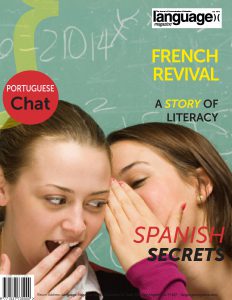July 2016 — Inside the Issue
Competing Culturally
The Building cultural competence is the core mission of this publication and a recurring theme of this column, so it’s hardly surprising that we welcome the recent Kurashiki Declaration (June 2016, p19) by the education ministers of the world’s most powerful economies that skills in this area should be an integral part of the Program for International Student Assessment (PISA).
This move should significantly increase the emphasis on cultural, and linguistic, education in the U.S. and other anglophone countries because of PISA’s weight as a measure of success of international educational systems. How often do we hear of Finland’s literary prowess and Singapore’s mathematical excellence? Despite fundamental differences in populations (size, diversity, wealth) being measured, PISA results are used as the international benchmark. The U.S. thrives on competition, and here’s a subject which should suit its very diversity. However, in order to excel across the board, we’ll need to prioritize world language education in a way that has yet to be seen.
Cultural competence may sound like another educational buzz phrase, but we’ve expected it of immigrants for centuries. Throughout history, immigrants have been asked to acquire the languages of their new homes, to understand the values of the societies into which they have moved, and to respect the customs of the communities which happened to be there before their arrivals. Civics and English classes have been the basis of cultural education for newcomers to the U.S. since its creation. And the U.S. is not alone; every nation that experiences significant immigration takes steps to accelerate the integration of its latest citizens by encouraging adoption and understanding of the culture into which they have moved.
More recently, we’ve recognized that it’s a two-way street—that members of the dominant community benefit from acquiring knowledge and understanding of the cultures that immigrants bring with them. Not only does such knowledge enrich our everyday lives and relationships but it also helps us understand the bigger picture of the increasingly global world into which we are born and opens the door to new opportunities in all aspects of life—spiritual, artistic, personal, gastronomic, economic—the list is endless.
Acquisition of language skills is at the core of cultural competence, but it has never been given the weight it merits in the U.S., so we must campaign to ensure that the new PISA guidelines make language central to requirements and that our educational systems do not shy away from language education through fear of failure. As language teachers, literacy advocates, study abroad advisers, educators, and administrators in the field, we know one how difficult it is to understand a culture without knowing its language. It will take time, but we have the advantages of experience, technology, and the resource of heritage language speakers to help us build the language-learning infrastructure required to succeed—so all we need now is the desire.
Cultural competence is probably the most valuable skill that students of all ages can acquire. Not only does it prepare them for the opportunities and challenges of globalization outside of national boundaries but it also helps them to make the most of the increasingly diverse communities on their doorsteps, thereby reducing the risk of conflict and enabling the prospect of problem solving on a global scale. PISA gives us the incentive to align our educational systems with 21st-century priorities, opportunities, and challenges. We must take advantage of our inherent competitive spirit to make language education a national priority.
Inside the Issue
|
Spanish Focus America’s Lingua Franca? Could Spanish become the language of choice throughout the Americas? Learning with Purpose Kristal Bivona looks at teaching specialized Spanish programs. Study Travel Costa Rica & Guatemala |
Why French? Kathy Stein-Smith explains why demand is growing for French the world over. A Whole Lot of Axolotls Paula Cuello & Lori Langer de Ramirez explore environmental studies in the Spanish classroom. A Literacy Autobiography Yew Hock Yeo, Phyllis Ghim-Lian Chow, & Stephen Krashen share a tale worth reading. |








